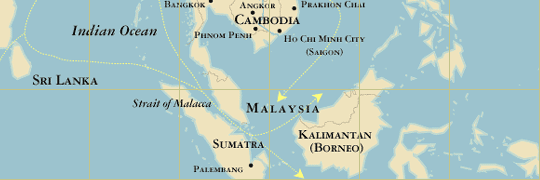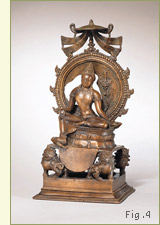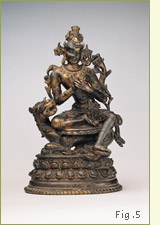|
|
|



 
   
Shrivijayan Empire
Buddhism flourished in many areas of Southeast Asia, and the maritime empire of Shrivijaya played a crucial role in the cross-pollination of Buddhist culture in Asia. This wealthy kingdom, which was the dominant force in the region between the seventh and eleventh centuries, controlled large parts of southern Thailand, Malaysia, and the present-day Indonesian islands of Sumatra and Java. Until 1025, it also controlled the Strait of Malacca, the strategic sea passage between the Bay of Bengal and the Gulf of Thailand. Shrivijaya was therefore a key intermediary between India and China and Buddhist scholars from both countries often spent years studying Mahayana and Vajrayana Buddhism in Shrivijaya's famed monasteries. For example, in 671, the Chinese pilgrim Yijing reported that an international community of roughly 1,000 monks were studying in the Shrivijayan capital. An image of Manjushri, the Bodhisattva of Wisdom (Fig. 4), belongs to the Shrivijayan tradition of sculpture but bears a strong resemblance to Indian Pala-period sculpture as evidenced by his swaying body and lotus-throne with a pearl-edged top rim, features seen on Pala-period works (Fig. 5). between the Bay of Bengal and the Gulf of Thailand. Shrivijaya was therefore a key intermediary between India and China and Buddhist scholars from both countries often spent years studying Mahayana and Vajrayana Buddhism in Shrivijaya's famed monasteries. For example, in 671, the Chinese pilgrim Yijing reported that an international community of roughly 1,000 monks were studying in the Shrivijayan capital. An image of Manjushri, the Bodhisattva of Wisdom (Fig. 4), belongs to the Shrivijayan tradition of sculpture but bears a strong resemblance to Indian Pala-period sculpture as evidenced by his swaying body and lotus-throne with a pearl-edged top rim, features seen on Pala-period works (Fig. 5).
Back | Next
|
|
